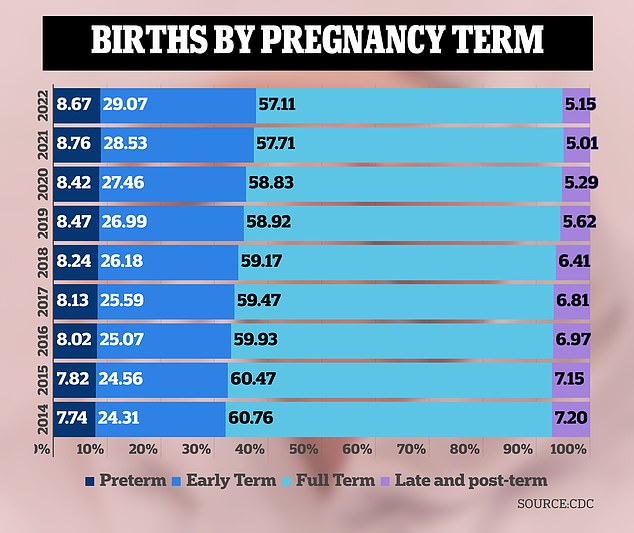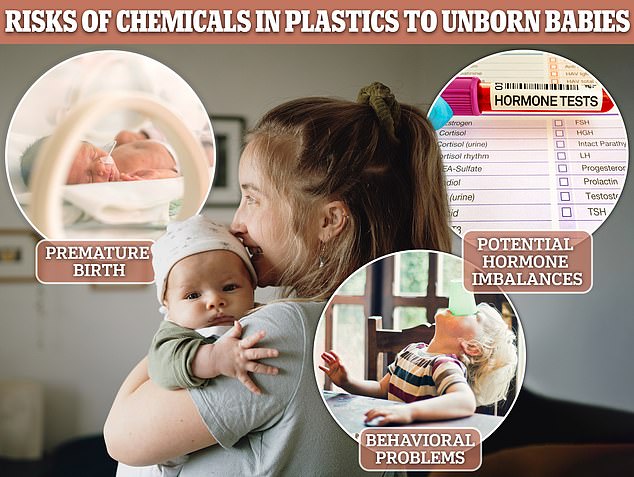Chemicals used to make plastic containers for water, food and cosmetics, known as phthalates, are believed to be responsible for nearly 60,000 premature births a year in the United States.
Researchers at New York University Grossman School of Medicine estimated that about 10 percent of all premature births in 2018 were linked to the body’s hormone-disrupting chemicals, which are used to make plastics more flexible. and durable.
The study found that the 10 percent of pregnant women with the highest levels of phthalates in their blood were twice as likely to give birth to their babies before 37 weeks.
A premature baby is one born before 37 weeks, while a full-term pregnancy is one that is between 39 and 40 weeks.
Women may be able to stay away from alcohol and sushi during pregnancy, but phthalates are nearly impossible to avoid, earning them the nickname “everywhere chemicals.”
Exposure to chemicals in utero can wreak havoc on a developing baby’s endocrine system, setting him up for an imbalance of sex and thyroid hormones, as well as problems with his motor skills and developmental delays later in life. .
The latest research from New York University researchers found that daily exposure to phthalates, chemicals used to make plastic packaging for food and many cosmetics, may be linked to nearly 56,600 premature births in the U.S. in 2018. .
Phthalates are considered endocrine disruptors due to their harmful effects on the body’s natural hormonal balance.
Babies are exposed in utero when phthalates in the mother’s blood pass through the placenta to the fetus, and the consequences of that exposure range from low birth weight to memory and learning problems later in childhood.
Phthalates have a relatively short half-life, meaning they break down within hours in the body, unlike PFAS, or “permanent chemicals,” which also coat plastics but remain in the body much longer. .
But like PFAS, phthalates are found in hundreds of products, including vinyl flooring, shower curtains, toys, food packaging, cosmetics and cleaning products, so exposure to them is constant.
For the study, New York University researchers used data from the Environmental Influences on Child Health Outcomes (ECHO) program, a research initiative led by the National Institutes of Health, to explore the effects of various environmental, social and and economics in children’s health and ways to improve it.
They analyzed urine samples taken from pregnant women at three different times during their pregnancies, measuring 20 different metabolites, or end products of the body’s digestion of chemicals.
In the process, they also compared specific types of phthalate, including di-2-ethylhexyl phthalate (DEHP), which is commonly found in IV bags and other medical devices.
The researchers then looked for links between the levels of those metabolites and premature births.
When they grouped mothers by the amount of DEHP metabolites in their urine, the 10 percent with the highest levels were 50 percent more likely to deliver their babies before 37 weeks.
Although we are only two weeks away from what is considered a full-term pregnancy, the baby’s brain, lungs, and liver continue to develop. Being born too soon, especially before 32 weeks, can increase a baby’s risk of a host of immediate and long-term health problems.
The researchers also found that the risk of preterm birth doubled for women exposed to the highest amounts of commonly used alternatives to DEHP found in wires, children’s toys, medical tubes and drinking straws compared to those who had little. or no exposure.

Studies have suggested that when phthalates cross the placenta, they alter the thyroid function of the fetus, slowing the baby’s growth into early childhood. The chemicals have also been linked to learning delays, behavioral problems and asthma in children exposed in utero.

A report from the Centers for Disease Control and Prevention reported an overall increasing trend in premature and premature births.
Dr. Leonardo Trasande, one of the leading researchers on the effects of the environment on children’s health and author of the study, said: “These results demonstrate the need to regulate phthalates as a class rather than trying to address them one by one”.
“Otherwise, it is likely that within a few years researchers will find the same results from studies on the next group of chemicals used as substitutes.”
Premature births are increasing overall, and the pervasiveness of environmental contaminants such as phthalates and permanent chemicals may be playing a role.
A report from the Centers for Disease Control and Prevention found that preterm births, defined as a birth before 37 weeks of gestation, increased 12 percent between 2014 and 2022, from 7.7 percent to 8. 7 percent.
In 2022, provisional data from the CDC shows that 3.66 million babies were born, meaning 318,400 of those children were born premature.
A growing body of research shows that phthalates act as endocrine-disrupting chemicals, meaning they mimic or interfere with the body’s hormones.
Studies have suggested that when phthalates cross the placenta, they affect the thyroid function of the fetus, slow down a baby’s growth until early childhood.
In addition to increasing the risk of preterm birth, in utero exposure has been linked to cases of childhood asthmabehavioral problems and cognitive delays.
A 2018 study of more than 1,300 Swedish and American children found that a higher level of phthalate exposure in utero increased the child’s chances of having communication and language delays.
Children whose mothers had twice as much exposure to two types of phthalates were 30 percent more likely understand fewer than 50 words, the threshold for a language delay.
And prenatal exposure to DEHP has been shown to influence a child’s behavior with what may be long-lasting consequences.
A report published in 2023 in the magazine NeuroToxicology As reported at 24 months of age, children with elevated prenatal exposure to phthalates, as indicated by higher levels in maternal urine, had greater challenges in social skills.
These included greater emotional reactivity, symptoms of anxiety and depression, withdrawal from social interactions, and behavioral problems compared to children who had lower levels of prenatal phthalate exposure.
With a growing body of evidence showing the serious negative effects of phthalates on both adults and fetuses, dozens of scientists are calling for their elimination from all consumer products.
They have partnered with health workers and child health advocates to form Project TENDR, which stands for Addressing Environmental Risks of Neurodevelopment.
Stephanie Engel, a professor at the Gillings School of Global Public Health at the University of North Carolina at Chapel Hill and a member of the group, saying: ‘There are now dozens of studies from countries around the world finding adverse associations between phthalate exposure and multiple aspects of brain development, including effects on behavior, cognitive function, and even brain white matter microstructure. brain.
“There is no compelling reason to continue waiting for more evidence when phthalates can be eliminated from most uses.”

